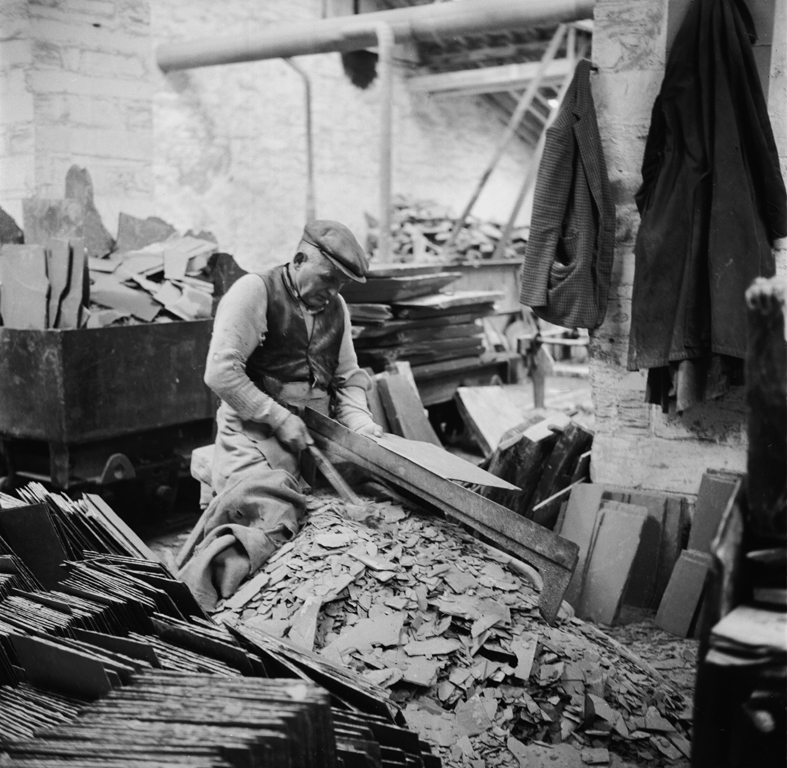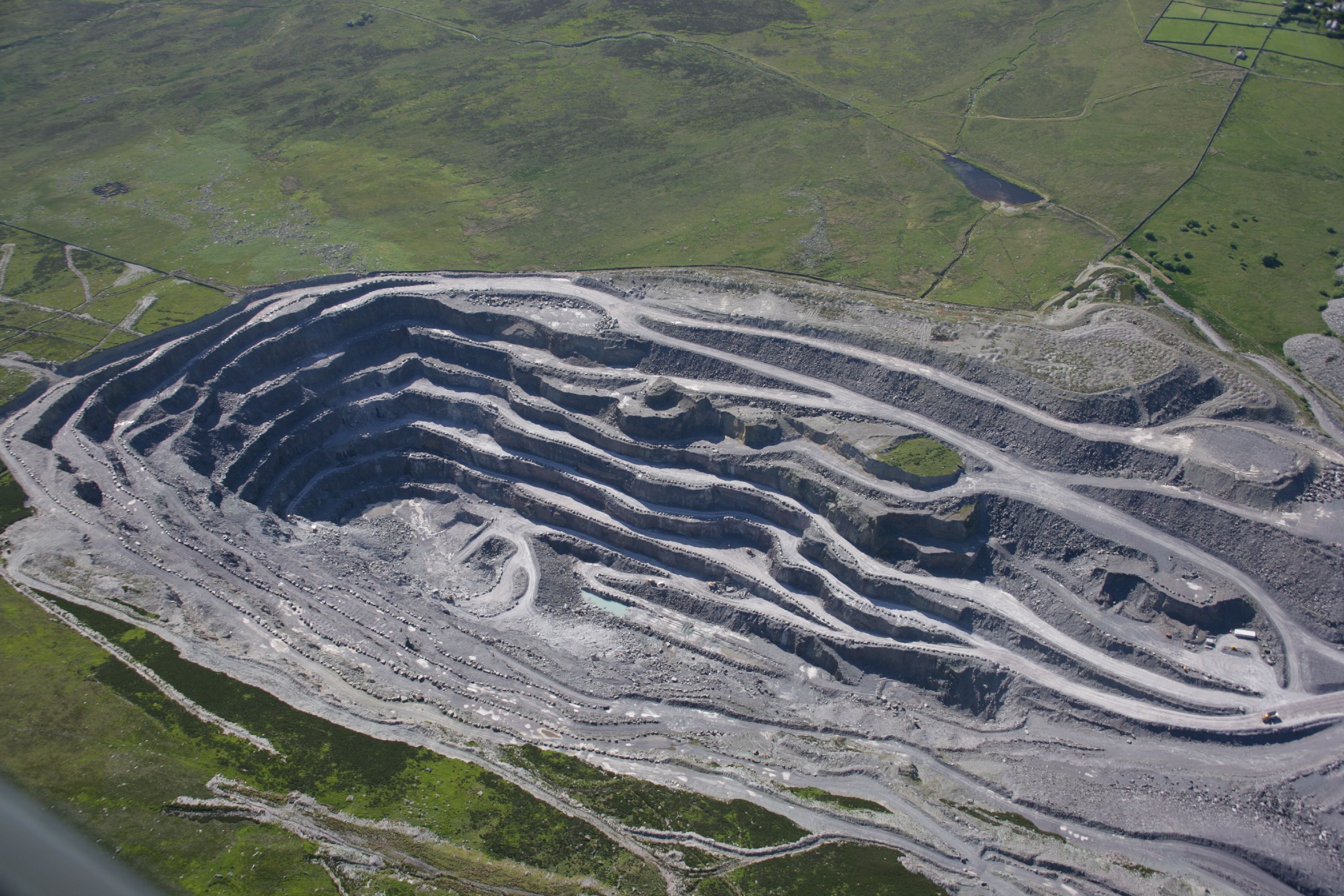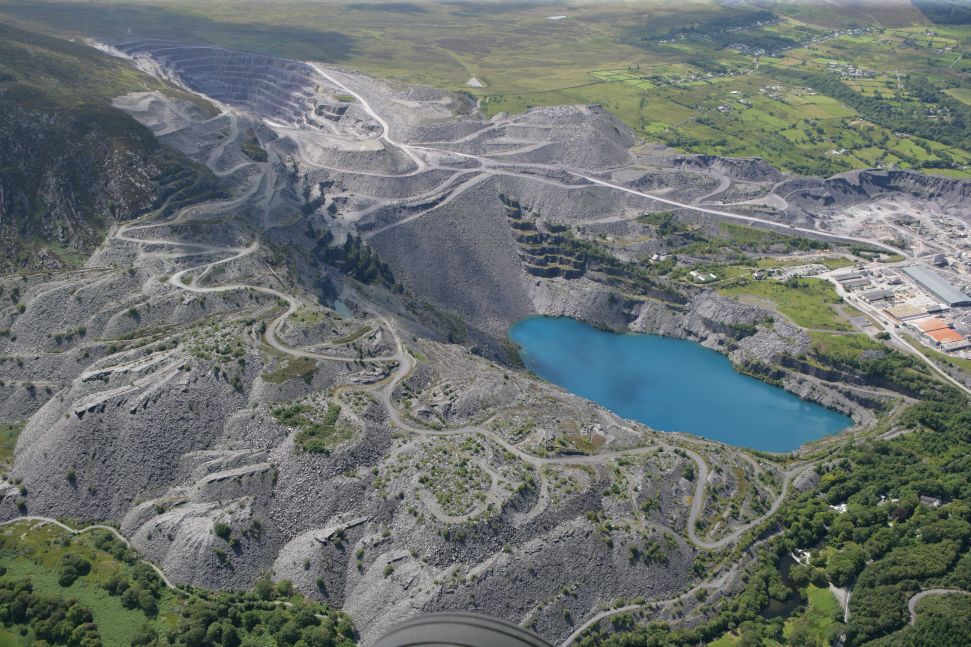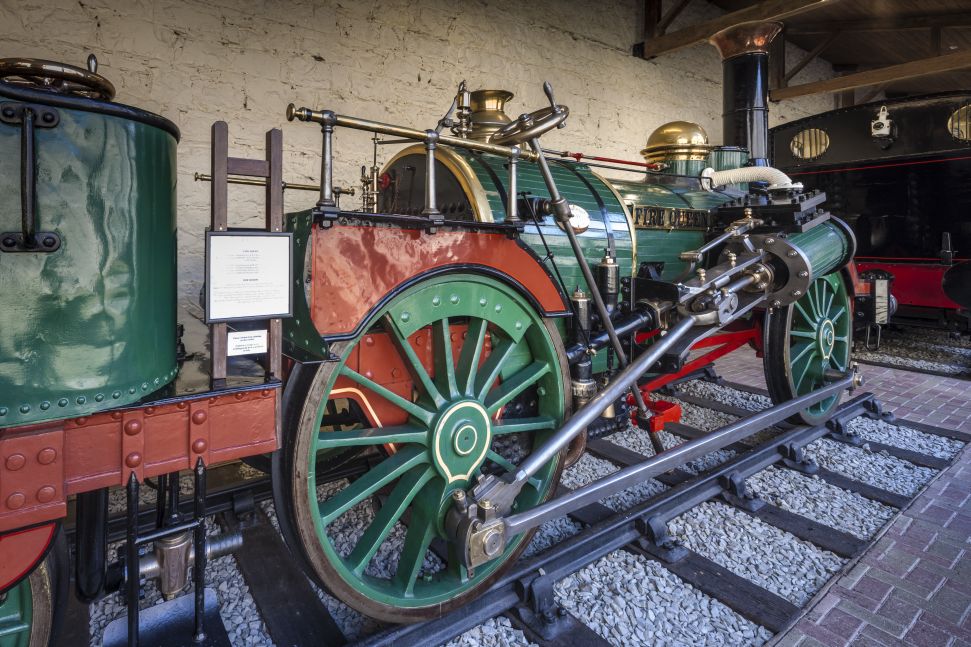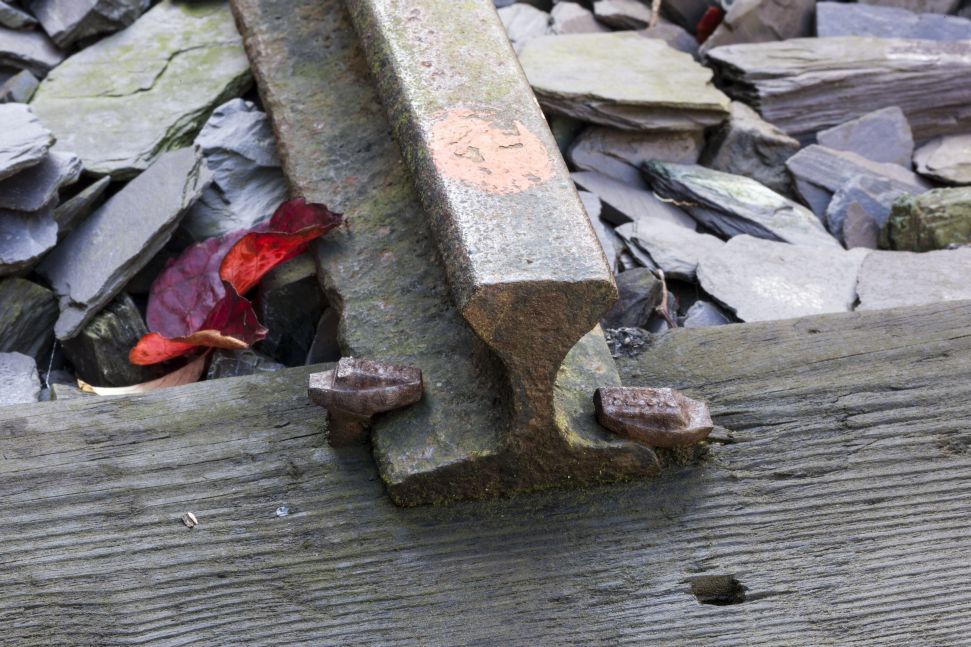Penrhyn Quarry - Overview
Large-scale slate quarrying started at Penrhyn Quarry in 1770 under the ownership of Richard Pennant, who had inherited the Penrhyn estate through his wife, Ann Warburton. Over the next one hundred years, the quarry developed into the largest slate workings in the world, with a workforce of c.3,000 people and its main pit measuring almost a mile in length. With the help of specially laid railways, the slates were transported from the quarry to Port Penrhyn, just outside Bangor, to be shipped to the four corners in the world. Thanks to its high quality and it’s variety of shades, Welsh slate was considered to be the best roofing material available. It was also used as fencing and building material, flagstones, bespoke furniture, table wear, ornate headstones and decorative masonry.
Conditions in the quarries were life-threatening as the quarry men were suspended from ropes along the rock face and used explosives to remove large slabs of rock. If they did not suffer loss of limb or life, many quarry-men developed silicosis as tiny particles of dust from splitting slates settled in their lungs.
Owing to the adverse working conditions and the notoriously low wages paid to the quarrymen, Penrhyn Quarry saw a number of strikes towards the end of the nineteenth century. Lasting from 1900 to 1903, the Great Strike was the longest labour dispute in British history. It is estimated that nearly a quarter of the population across north Wales was affected. After three years of stalemate, the quarrymen ran out of resources and were forced to return to work at much decreased wages. In the aftermath, orders for north Welsh slate dropped considerably. Since then slate production has been in decline.
Throughout the nineteenth century, the sheer size of Penrhyn Quarry with its thousands of workers drew a great number of tourists. Rides in the open slate carriages hurtling down the inclines gave great pleasure to Victorian thrill-seekers. Today, the open carts may have disappeared, but tourists continue to zip around the open pit, this time suspended from wires.
Accounts of Travel
Briefe eines Verstorbenen, 1828
Hermann von Pückler-Muskau (1785 – 1871)
Ein sehr romantischer Weg brachte mich, erst durch den Park, dann am Saum eines schön bewaldeten Bergstroms hin, in einer Stunde nach dem Schieferbruch, der 6 Meilen vom Schloß im Gebürge liegt. ... Fünf bis sechs hohe Terrassen von großem Umfang steigen an den Bergen empor, und auf ihnen wimmelt alles von Menschen, Maschinen, Prozessionen von hundert aneinander gehängten, schnell auf Eisenbahnen hinrollenden Wagen, Lasten heraufziehenden Krahnen, Wasserleitungen, und so weiter. Ich brauchte ziemlich lange, um das Ganze nur flüchtig zu besehen. Um zu einem entfernteren Theile des Werks zu gelangen, wo man eben die Felsen mit Pulver sprengte, was ich zu sehen wünschte, mußte ich mich auf einem der kleinen Eisenwagen, die zum Transport des Schiefers dienen, durch eine pechschwarze, nur vier Fuß hohe und vierhundert Schritt lange, durch den Felsen gehauene Gallerie auf dem Leibe liegend fahren lassen. Dies geschah vermittelst einer Winde. Es ist eine böchst fatale Empfindung, sich durch diese schmale Schlucht mit tausend unregelmäßigen Zacken, welche man, am Eingange wenigstens, deutlich sieht, bei ägyptischer Finsterniß mit großer Schnelle durchreißen zu lassen, welches Fremde auch gewöhnlich ablehnen. Man kann sich des Gedankens nicht erwehren, daß wenn man, ohngeachtet der beruhigenden Versicherung des Führers, der zuerst voraus fährt, nun dennoch an irgend eine dieser Zacken anstieße, man auch unfehlbar ohne Kopf an der andern Seite ankäme. Nach Passirung dieser Gallerie mußte ich noch auf einem, nur zwei Fuß breiten Wege ohne Geländer, am Abgrunde hinwandern, bis ich durch die zweite niedrige Höhle endlich zu dem gewünschten, in der That schaudervoll prächtigen Ort, gelangte. Hier schien man sich schon in der Unterwelt zu befinden! Die mehrere hundert Fuß hohen, spiegelglatten, abgesprengten Schieferwände ließen vom blauen Himmel kaum so viel noch sehen, um Tag von Dämmerung unterscheiden zu können. Der Boden, auf dem wir standen, war gleichfalls abgesprengter Felsen, und in der Mitte bereits ein tiefer Spalt, von ohngefähr sechs bis acht Fuß Breite, schon weiter herunter gearbeitet. Ueber diese Schlucht amüsirten sich einige Kinder der Steinarbeiter, halsbrechende Sätze zu machen, um ein paar Pence dafür zu verdienen; an den Felsenwänden aber hingen überall Bergleute, gleich schwarzen Vögeln mit ihren langen Eisen pickend, und Schieferblöcke mit Geprassel herunter werfend. Doch jetzt schien das ganze Gebürge zu wanken, lauter Warnungsruf erschallte von mehreren Seiten, die Pulvermine sprang. – Ein großer Felsen löste sich nun von hoch oben langsam und majestätisch ab, stürzte gewaltig in die Tiefe, und während Staub und abspringende Steinstückchen die Luft gleich dickem Rauch verfinsterten, hallte der Donner im wilden Echo rings um uns wieder. Diese, fast täglich an verschiedenen Orten des Steinbruchs nothwendigen, Operationen sind so gefährlich, daß, nach der eignen Versicherung des Direktors, man bei dem ganzen Werk im Durchschnitt jährlich auf 150 Verwundete und 7 bis 8 Todte rechnet! Ein zu diesem Behuf eignes bestimmtes Hospital nimmt die Blessirten auf, und ich selbst begegnete beim Herreiten, ohne es zu wissen, der Leiche eines vorgestern Gebliebenen, car c’est comme une bataille. Die Leute waren so aufgeputzt und mit Bergblumen geschmückt, daß ich die Prozession im Anfang für eine Hochzeit hielt, und fast erschrack, als auf meine Frage, wo der Bräutigam sey, einer der Begleiter schweigend auf den nachfolgenden Sarg wieß. ...
Da wir selbst von dem Foyer nicht zu weit entfernt standen, so benutzte ich den Wink, und machte wieder linksum, durch die höllische Gallerie, um mir die friedlicheren Arbeiten zu besehen. Diese haben vielfaches Interesse. So kann z. B. Papier nicht zierlicher und schneller beschnitten werden, als hier die Schiefertafeln, und kein Kienblock kann leichter und netter spalten, als die Steinblatten, die der Arbeiter mit geringer Mühe durch einen einzigen Schlag des Meißels in Scheiben wie die dünnste Pappe, und von 2 bis 4 Fuß im Durchmesser, zertheilt.
I followed a very romantic road, which led me through the park, and then along the bank of a beautifully wooded mountain stream, and in about an hour arrived at the slate quarry, which lies in the midst of the mountains, six miles from the castle. ... Five or six high terraces of great extent rise one above another on the side of the mountain; along these swarm men, machines, trains of a hundred wagons attached together and rolling rapidly along the iron railways, cranes drawing up heavy loads, watercourses, &c. It took me a considerable time to give even a hasty glance at this busy and complicated scene. In order to reach a remote part of the works, where they were then blasting rocks with gunpowder, – a process which I had a great desire to see, – I was obliged to lie down in one of the little iron wagons which serve for the conveyance of the slate, and are drawn by means of a windlass through a gallery hewn in the solid rock, only four feet in height, four hundred paces in length, and pitch dark. It is a most disagreeable sensation to be dragged through this narrow passage at full speed, and in Egyptian darkness, after having had ample opportunity of seeing at the entrance the thousand abrupt jagged projections by which one is surrounded. Few strangers make the experiment, spite of the tranquillizing assurances of the guide who rides before. It is impossible to get rid of the idea that if one came in contact with any of these salient points, one would, in all probability, make one’s egress without a head. After passing through this gallery, I had to walk along a path at the edge of the precipice, only two feet wide, and without any railing or defence; then to pass through a second low cavern, when I reached the fearfully magnificent scene of operations.
It was like a subterranean world! Above the blasted walls of slate, smooth as a mirror, and several hundred feet high, scarcely enough of the blue heaven was visible to enable me to distinguish mid-day from twilight. The earth on which we stood was likewise blasted rock; just in the middle was a deep cleft six or eight feet wide. Some children of the workmen were amusing themselves in leaping across this chasm, for the sake of earning a few pence. The perpendicular sides were hung with men, who looked like dark birds, striking the rock with their long picks, and throwing down masses of slate which fell with a sharp and clattering sound. But on a sudden the whole mountain seemed to totter, loud cries of warning re-echoed from various points, – the mine was sprung. A large mass of rock loosened itself slowly and majestically from above, fell down with a mighty plunge, and while dust and splinters darkened the air like smoke, the thunder rang around in wild echoes. These operations, which are of almost daily necessity in one part or other of the quarry, are so dangerous, that, according to the statement of the overseer himself, they calculate on an average of one hundred and fifty men wounded, and seven or eight killed in a year. An hospital, exclusively devoted to the workmen on this property, receives the wounded; and on my way I had met, without being aware of it, the body of one who had fallen the day before yesterday; ‘car c’est comme un champ de bataille’. The people who escorted it were so smartly dressed and so decorated with flowers, that I at first took the procession for a wedding, and was shocked when, in answer to my inquiry for the bridegroom, one of the attendants pointed in silence to the coffin which followed at some distance. ...
As we ourselves were not far enough from the ’foyer’, I instantly obeyed the signal, and turned on the left through the infernal gallery, to inspect the more peaceful operations: these are extremely varied and interesting. Paper cannot be cut more neatly and rapidly than slates are here; and no deal board can split more easily and delicately than the blocks which the workmen with one single stroke of the mallet divide into slices, from three to four feet in breadth, as thin as the thinnest pasteboard.
(Tour in England, Ireland, and France, in the Years 1828 & 1829. With Remarks on the Manners and Customs of the Inhabitants, and Anecdotes of Distinguished Public Characters. In a Series of Letters. By a German Prince. Ed. B –. Vol. 1. London: Effingham Wilson, 1832)
Medicinische Reisebriefe aus England und Holland, 1866
Heinrich Rohlfs (1827 – 1898)
Die meisten Arbeiter verließen die Steinbrüche, um ihr Mittagsmahl einzunehmen. Wir kamen noch gerade zur rechten Zeit an, um das Sprengen einiger großen Steinmassen mitanzusehen. Dasselbe findet jede Stunde Statt. Eine kleine rothe Fahne wird dann als Warnungszeichen so lange ausgesteckt; nach kurzer Zeit hörten wir krachende Schüsse, die durch ein vielfaches Echo unter den steilen Abhängen verstärkt wurden. An verschiedenen Stellen bemerkt man dann Rauch aufsteigen und große Steinmassen in das Thal hinabrollen. „Hurtig mit Donnergepolter entrollte der tückische Marmor.“ Die Höhe mag circa 300 Fuß betragen. Die unten beschäftigten Arbeiter erscheinen klein wie die Ameisen. Den Schieferbrüchen entlang befinden sich viele Absätze und Wege, auf denen Arbeiter gingen, und andere an Stricke befestigt arbeiteten.
Das Imposanteste sind zwei in der Mitte der Steinbrüche ganz freistehende, kegelförmige Pfeiler von der Höhe von 250 – 300 Fuß.
Wie zwei Säulen erscheinen sie den Augen aus der Ferne; die Waterloosäule in Hannover und die Vendomesäule in Paris würden gegen diese Naturproducte kleinlich in ihren Dimensionen erscheinen. Mit Absicht hat man diese Säulen stehen lassen. Und in der That trägt ihr Anblick sehr dazu bei, das Majestätische der ganzen Scenerie zu erhöhen. Der durch die gesprengten Felsenstücke gewonnene Kessel wird natürlich von Tag zu Tag weiter. Das Schieferlager soll sich aber noch mehrere Meilen in’s Land hineinstrecken, so daß bis jetzt nichts ferner liegt als der Gedanke, es würde einmal eine Zeit kommen, wo es mit der Ausnützung dieses Industriezweigs vorbei sei. An diesen beiden Säulen, da sie nach allen Seiten frei stehen, und natürlich ganz zu umgehen sind, kann man die verschiedenen Lager des Schiefers auf’s Schönste studiren. Er erscheint als grauer, grünlicher und röthlicher Schiefer und ist von einigen weißen Quadern und gelblichen Streifen durchzogen.
Später besuchten wir noch mehrere Arbeiter in ihren Werkstätten, sahen ihnen zu, wie sie die Schiefersteine spalteten und zu schnitten. Wir bewunderten ihre große manuelle Geschicklichkeit. Viele Hunderte von Arbeitern werden in diesen Brüchen beschäftigt.
Reich belohnt durch die imposanten Natureindrücke und die durch diesen blühenden Industriezweig uns gewordenen Anregungen, fuhren wir nach einigen Stunden nach Bangor zurück.
Most of the workers left the quarries in order to take their lunch. We had arrived just in time in order to observe the blasting of enormous amounts of stone which occurs every hour. The entire time, a small red flag is raised as sign of warning; after a short while, we heard crashing shots, which a compounding echo intensified under the sheer cliffs. Next, smoke begins to rise from various locations and colossal amounts of stones tumble down into the valley. ‘The mass / Rush’d again, obstinate, down to the plain.’ The height of the drop is estimated at circa 300 feet. The busy workers down below appear small as ants. All along the slate quarries are drops and paths on which the workers made their way and others worked attached to suspended ropes.
The most impressive sight is offered by two cone-shaped pillars, 250 to 300 foot in height, standing unsupported at the centre of the quarries.
Like two columns they appear to distant eyes; against these products of nature, the Waterloo Column in Hanover and the Vendome Column in Paris would appear but minute in their dimensions. These columns have been left standing deliberately. And indeed, their appearance contributes greatly to the majestic sight of the whole scenery. Originating from the blasted rocks, the cauldron naturally grows wider day by day, but the slate deposits are said to extend further inland for many miles so that nothing is further from the mind than imagining a time when the utilisation of this branch of industry may be over. It is possible to study the various slate deposits most beautifully by walking around the two free-standing pillars, which are exposed on all sides. The slate displays itself in grey, green and red and is shot through with white cubes and creamy stripes.
Later we visited some workers in their splitting shelters, watched them split and cut the slates, and marvelled at their great dexterity. Many hundreds of workers are employed in these quarries.
Richly rewarded by the imposing impressions of nature and stimulated by this flourishing branch of industry, we returned to Bangor after a few hours.
Essai sur l’état actuel de l’industrie ardoisière en France et en Angleterre, suivi de quelques observations pratiques sur la formation du schiste ardoisier, c. 1850s
L. Smyers ( – )
Pour avoir une idée de ce centre immense et qui n’a pas son pareil dans le monde, il faut se figurer une montagne de 600 pieds anglais de hauteur, au faîte de laquelle on a commencé les travaux d’exploitation en taillant des gradins en hémicycle de 40 pieds de hauteur, jusqu’au niveau des eaux. Cette disposition donne au tout l’aspect d’un cirque immense. ...
Lorsque les explosions commencent à se faire entendre, on croirait assister à un siège en règle. On peut voir alors, au milieu des nuages de fumée, rouler pêle-mêle du haut des gradins, des blocs d’ardoise de grosseurs diverses détachés et lancés par la poudre. Quand tout ce bruit cesse, il y a un moment de silence et d’attente, quelque mine peut n’être pas partie, et il ne faut pas s’aventurer. Au bout de quelques minutes, on entend un coup de trompe et on voit des centaines d’hommes sortir de tous les coins où ils s’étaient abrités, ainsi que du petit bâtiment, et en un rien de temps tout est de nouveau en activité pour recommencer deux heures après.
J’ai assisté deux fois à ce spectacle du haut de l’exploitation, et je n’ai jamais rien vu qui puisse lui être comparé.
La propriétaire de Penrhyn a fait construire tout un village pour loger ses ouvriers; j’ai admiré la symétrie, la propreté et le bon goût de ces maisons, leur parfait alignement, la largeur de la rue principale. De loin, l’ensemble de ces constructions, pour ainsi dire neuves, offre l’aspect d’un de ces villages suisses qu’on ne se lasse pas de voir. Près de là se trouve le château rarement habité du maître, au milieu d’un parc qui ne cède rien à nos plus beaux parcs français.
Quand on vu Penrhyn, on se demande si on n’a pas tout vu, et s’il est utile d’aller ailleurs.
To get an idea of this immense centre that is unparalleled worldwide, you have to imagine a mountain that is 600 feet high, with semi-circular terraces 40 feet high carved into it all the way from its summit down to water level. This layout gives the whole the impression of a vast amphitheatre. ...
When the explosions sound you might think that you were witnessing a proper siege. Then you see, in the middle of the clouds of smoke, rolling chaotically from the top of the terraces, blocks of slate of various size loosened and hurled by the powder. When all this noise ends, there is a moment of silence and waiting: some charge or other may not have gone off, and no risk must be taken. After a few minutes a horn is heard and hundreds of men come out from all the nooks and crannies where they had been sheltering, as well as from the little building, and in no time at all everything is busy once more until it all happens again in two hours’ time.
I have witnessed this scene twice from the top of the exploitation, and have never seen anything that could be compared to it.
The owner of Penrhyn had a whole village built to accommodate his workers; I admired the symmetry, the tidiness and the good taste of these houses, perfectly aligned around a wide main street. Seen from a distance these new buildings, so to speak, give the impression of one of those Swiss villages that one never tires of seeing. Nearby is the castle, rarely inhabited by the master, set in grounds that are every bit as good as our most beautiful French properties.
When you have seen Penrhyn, you wonder whether you have not seen it all, and that going elsewhere would be pointless.
"Notes d’un voyage aux ardoisières du Pays de Galles", c. 1880
C. Larivière ( – )
L’exploitation en colline est très repandue, ainsi qu’on peut s’en rendre compte par l’examen de la disposition des couches sur la coupe générale. C’est par cette méthode que sont exploitées les deux plus grandes ardoisières du North-Wales. La plus ancienne, Penrhyn Slate Quarry, dont l’origine remonte au temps de la reine Elisabeth, est située à 6 kilomètres environ au sud-est de Bangor, à 1,500 mètres au delà du village de Bethesda. ...
Chaque mois, le manager fixe, s’il y a lieu, la valeur du poundage ou indemnité d’avancement propre à chaque chantier, suivant les accidents qu’il a rencontrés (crych, post, sparry vein).
Le roulage des matières utiles ou stériles se fait par chemins de fer desservant chaque niveau et aboutissant: d’un côté, aux ateliers de fente, de l’autre, au hottoir.
Des plans inclinés automoteurs descendent les ardoises fabriquées des différents étages et remontent les wagons vides. Les wagons pleins sont formés en trains et remorqués par locomotives, soit à Port-Penrhyn pour y être embarqués, soit à l’atelier de sciage.
Le service des gradins inférieurs, très voisins du fond de la vallée, a exigé un aménagement spécial. Afin de remonter sans frais les matières au niveau actuel des hottoirs, où sont établis les ateliers de fente et se débarrasser de l’épuisement des eaux, on a creusé au dernier banc un puits relié par un long coupement à une balance hydraulique. Ce coupement sert à la fois à l’écoulement des eaux et à la circulation des wagonnets; une galerie, placée à un niveau inférieur, évacue sur le flanc de la montagne les eaux de la carrière et celle de la balance alimentée par un cours d’eau capté à la surface; ce même cours d’eau sert à actionner les moteurs des ateliers de réparation.
The exploitation of the hillside has been taken very far, as can be seen by examining the position of the layers in cross section. It is by this method that the two largest slate quarries in north Wales are exploited. The older of the two, Penrhyn Slate Quarry, whose origin dates from the time of Queen Elizabeth, is some 6 kilometres south-east of Bangor, 1,500 metres beyond the village of Bethesda. ...
Every month the manager sets, if needed, the value of poundage or the payment relating to each work site, depending on what forms he has found there (crych, post, sparry vein).
The haulage of useful or waste material is done by railway lines that serve each level, running between the splitting shelters at one end and the waste tip.
Via railed inclined planes, the finished slates descend from the various levels and automatically empty wagons are pulled back up. The filled wagons are formed into trains and towed by locomotives, either to Port-Penrhyn to be loaded onto a ship there, or else to the sawing workshop.
Servicing the lower terraces, very close to the bottom of the valley, has necessitated a very particular set-up. So as to haul the material cost-free up to the current level of the waste tips, where the splitting workshops have been established, and to get rid of the pumped [i.e. excess, waste] water, a well has been dug on the last layer, that connects to a water-balance via a long leat. This leat acts both as a channel for the water and as a tramming level; a gallery, placed on a lower level, evacuates onto the mountainside the water of the quarry and of the balance fed by a stream of surface water; this same water serves to drive the water-wheels in the repair workshops.
